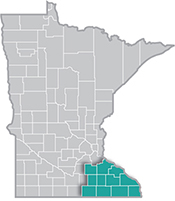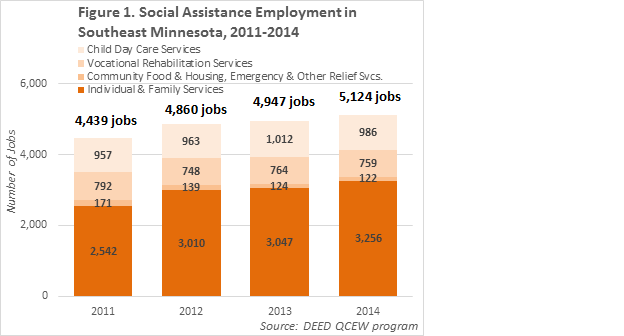 Southeast Minnesota is a health care and agricultural powerhouse. The region is home to the renowned Mayo Clinic and some of the world's most recognized food companies and brands.
Southeast Minnesota is a health care and agricultural powerhouse. The region is home to the renowned Mayo Clinic and some of the world's most recognized food companies and brands.
Advanced manufacturing is especially strong here, with machinery, chemicals, and electronics among the top products.
Want the freshest data delivered by email? Subscribe to our regional newsletters.
9/22/2015 2:23:55 PM
Everyone needs a little help from time to time. Luckily, social assistance programs are available to assist those in need with a variety of programs. Demand for social assistance has increased over the past four years, and as seen in figure 1, so has the number of workers in this field.

In fact, annual employment averages show an addition of 685 jobs from 2011 to 2014, a 15 percent increase. Part of this trend could be that the area was still recovering from the recession in the earlier years, making jobs in this field harder to come by.
This increase in jobs is great news for two groups of people: those seeking a job in social assistance, and those needing to use these services. Those seeking a job in the field have more opportunities to find work and may not feel as overwhelmed when starting because there are more co-workers to decrease workloads. Those seeking assistance may receive quicker and higher quality service due to more individuals working in the field and having more time to assist them.
There are four main areas within social assistance programs:
As shown in table 1, the majority of social assistance jobs in Southeast Minnesota were in individual and family services, followed by child day care services, vocational rehabilitation services, and community food and housing, and emergency and other relief services.

While there are more jobs in individual and family services, the highest average wages are found in the area with the least number of jobs and establishments - community food and housing, and emergency and other relief services. Vocational rehabilitation services had similar wages, while the lowest wages are found in the largest sectors: child day care services and individual and family services.
Contact Mark Schultz.